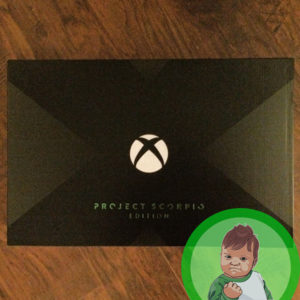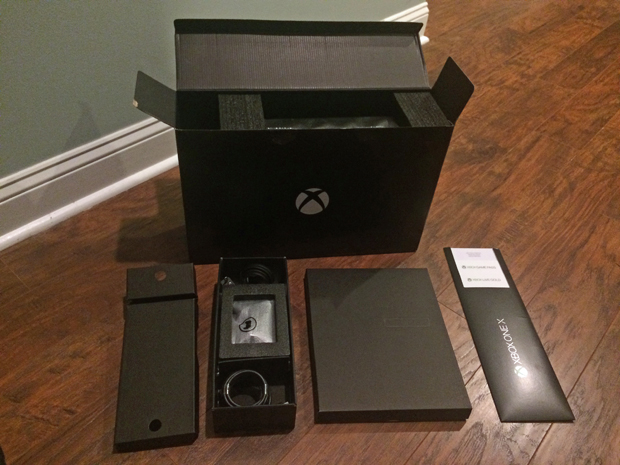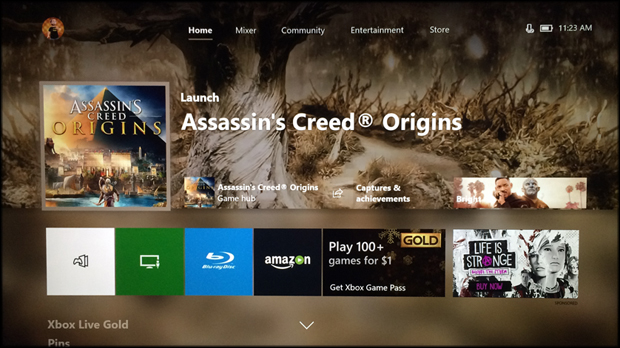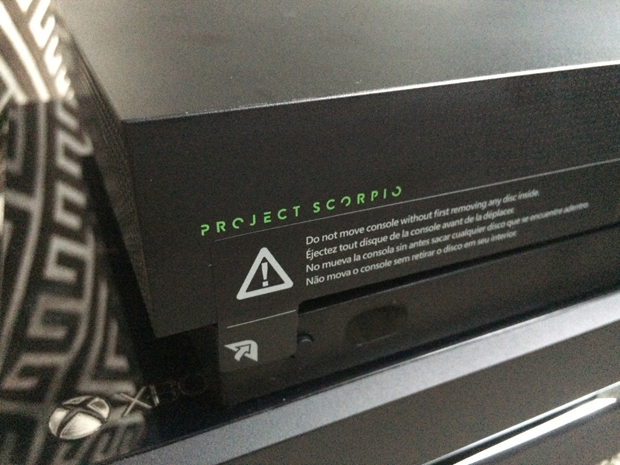The Xbox One X, Microsoft’s ‘Project’, Is a Robust Console Enhancement

Overall Grade
Pros
- -Full 4K/High Dynamic Range Compatibility
- -Solid and Sleek Craftsmanship
- -Extensive Overhaul of Tech
- -Effortless Transition From Older Xbox Ones
- -Several Generations of Backwards Compatibility
- -Onboard 4K/UltraHD Blu-ray Disc Drive
- -USB Port, Actual Buttons At Front
Cons
- -It's Still an Xbox One
- -Expensive In Comparison to Xbox One S
- -Lengthy Update Wait Times
Typically, the experience of buying a launch console falls into two categories. Under most circumstances, this momentous occasion involves a from-scratch videogame system with an entirely new body and series of jacks to plug stuff into, along with massively upgraded graphical capabilities and – both a positive and a negative – the process of getting all new games and accessories. Other times, gamers who already own one system will buy a recently updated version of said system, and that can be because of a reduction in build size, an electronic or mechanical advancement, or their current system is wheezing and on its last legs after long nights in the trenches of the gaming realm.
All their games and controllers still work on this new system as they did before, only it offers something a bit better, in one way or another, that an identical and likely cheaper replacement console wouldn’t. One of the above experiences should seem more exciting and fun, while the other should seem a lot more effortless and less costly. Microsoft’s Xbox One X sets its sights on both experiences, and, boy, does it hit the mark.
Long discussed under the moniker Project Scorpio, this new console was developed from the start with a certain objective in mind: to make current games and media look, sound, and perform better, and to give future releases the option of tapping into this improved hardware for more powerful gaming experiences. The decision to upgrade based on those qualifications has branded the Xbox One X as a console mostly designed for the “elite” or “hardcore” player, but even at its higher price point, the technology under the hood starts to look like a decent value for any number of consumers, from those new to this console generation to those wanting to hop into 4K media playback.
Most often, that boils down to one’s point-of-view and circumstances; in the instance of this review, for example, the Xbox One X will be filling the void of a bulky early-release Xbox One, which had an expanded hard-drive hooked up to it due to the small internal space of those systems. To this day, over years of continuous usage, that system still performs quietly and solidly … but the promise of hardware improvements, elevated backwards compatibility, and 4K playback proved compelling.

Included: Power Cable, HDMI 2.1 Cable, Vertical Stand, Riveting Literature, Lots of Black Foam.
While a Project Scorpio Limited Edition will be reviewed here, the differences between it and a standard Xbox One X are only cosmetic, both the console and the packaging presentation itself. While one can appreciate the Project Scorpio logos on the front of the system and one the bundled controller, along with the slight gradient coloring at the top of the system’s chassis and the black accents of the foam supports on the inside of the box, they are identical systems in terms of unboxing and performance.
What’ll be noticeable regardless of the system purchased will be the decreased size of the X in comparison to the original Xbox One, which had shinier plastic accents, wide vents for circulation, and an external power brick that could be difficult to deal with in cramped audiovisual setups. Piggybacking off the Xbox One S’s design improvements, the X sports a sleeker, slimmer, yet noticeably heavier chassis with seemingly less ventilation — though that doesn’t seem to impact the volume factor – and an internal power supply that’s utilized with a standard figure-8 cord. Despite the reduction in size, it feels even more substantial than the One. And I dig that it has actual push buttons for turning it on and ejecting a disc.
Unboxing, connecting, and setting up the Xbox One X was a simple and streamlined process, one that’ll seem almost identical to getting the original Xbox One ready to go. The power brick for the Xbox One will need to be removed, but the existing HDMI cable could feasibly be left in place and plugged into the rear of the Xbox One X; however, Microsoft have included a solidly-built (yet reasonably short) HDMI 2.1 cable that’ll better support 4K/High Dynamic Range (HDR) signals, so it’s worth considering a switch-out.
Ports are available at the rear for HDMI both in and out, so signals can be sent to receivers and TVs at the owner’s discretion, as well as a pair of USB ports for any number of useful devices, especially those expansion hard-drives … which might still be required since the system’s only working with 1TB of space, and those “enhanced” updates aren’t exactly small. After all those normal questions asked by the system upon being booted up – including getting internet connectivity up and running – the system will do a lengthy update, so grab a book, fix a sandwich, or plan on doing some housework.
After that, it’s all a matter of getting everything plugged back in and signing into an Xbox account. Surprisingly, reconnecting my external hard-drive containing my gaming library was incredibly fluid, instantly recognized and accessible after plugging it in at the back and signing in. Had the Xbox One X not required a lengthy update, it’d probably only take about 15-20 minutes to switch out systems into a functional state.

Before and After a Couple of Years of Slimming Down.
Getting the Xbox One X to handshake with 4K TVs and receivers for UltraHD content takes some finagling, but nothing too complicated, and the Xbox’s menus will help if roadblocks are hit. In terms of resolution, the appropriate signals obviously need to be chosen in the system itself and sent to the TV, but the TV (and receiver) might also need to be tinkered with so that the specific input channel will process the increased resolution and, more significantly, the HDR capabilities; static, stuttering, and crashing of the visuals might occur in the absence of doing that.
The system will also need to download a specific app from Dolby to decode ATMOS object-based audio, and the changes are toggled in-app to process and/or stream the high-definition audio; sending audio to a receiver is free out of the box, but a $15 fee will be applied to enable headset connectivity. Preparing for 4K gaming might seem like a daunting task for some, but Microsoft have made the process relatively user-friendly in pointing folks in the right direction if something’s awry.
Under the hood, the Xbox One X boasts enough processing capability for gaming enthusiasts to give Microsoft a stamp of approval in its claims of this being the “world’s most power console”. The technical specs are led by the system’s 6 teraflop GPU, which stands tall against most of the gaming PCs out there not rolling with graphics cards that rival the cost of the entire system itself, and are supported by a 2.3GHz CPU and 12GB of DDR5 memory. Comparisons to other systems not only give the Xbox One X an edge, but a significant edge in rendering more details, generating smoother motion, and keeping everything stable.
In general, the system has been designed to run all games on a higher base level, but numerous titles have been – and will be – optimized for 4K/HDR playback, which can be spotted on cover artwork somewhere near the corners in hard-to-miss text. Those that have been optimized require a graphics pack update that triggers upon booting them up, but the wait time for those isn’t significantly more than a general update. HDR-active titles will indicate the effect is live by a nifty colorful button at the top-right of the screen; Xbox One X Enhanced titles (click here to read them all) can be singled out in the gaming library through an option in the pull-down menu.

The Included Not-So-Elite But Still-Pretty-Great Controller.
The results are, indeed, impressive. Indicated by exploring the cluttered Egyptian architecture and sandy, occasionally verdant vistas of Assassin’s Creed Origins, the system’s capabilities to render dense clusters and gradations of graphical detail are monumental. Keep an eye out for the organic textiles of garments and the contours of foliage surrounding protagonist Bayek, which are incredibly sharp and show very little aliasing in motion.
Observing the horizons from vantage points yields a beautiful experience on the X, too, with coarse stone textures and wisps of clouds beautifully observable in the distance. Shadows in tombs contrast against flickering flames for an immense representation of HDR’s capabilities, adding lifelike depth and responsiveness to the expanses of echoic tombs. The ATMOS object-based sound environments further accentuate the confined chambers and sprawling citizen-filled deserts, with incredibly responsive fluidity while rotating Bayek’s perspective and navigating the roads on camel- or horse-back. The 2160p presentation holds up to the details and naturality of high-grade PCs.
Backwards compatibility has become a battlycry of sorts for Microsoft over the past couple of years, where they’ve begrudgingly transferred from wanting the Xbox One to concentrate on new games to making sure that every new free Xbox 360 title in their Games With Gold program would be playable. The Xbox One X continues that mantra by flexing new performance muscles with select titles, both from the 360 generation and, in something of a surprise, the classic Xbox; currently, only a dozen or so original Xbox titles are playable.
While a growing legion of 360 games continue to be backwards compatible on the One – click here for a full list – a select few have been christened as “enhanced” with spruced-up graphics, including Bethesda’s Elder Scrolls IV: Oblivion. Those expecting a night and day difference, transforming the standard game into a remastered or modded PC version, could be let down … but they also might, and deservedly should, be impressed with the restricted cleanup effort. Colors appear more vibrant and fluid, textures produce cleaner and nuanced details, and the environment’s depth brims with new life. It’s still got the flesh and bones of a decade-old game, but what’s been spruced up here looks stellar.

Cozying Up With Xbox’s New-ish User Interface. Streamlined is the Road To Awe.
Last year’s interim Xbox One re-release, the S, featured a few mild upgrades in the graphics department – notably, HDR support – but perhaps its biggest selling point came in its media playback: for a while, it was one of the least expensive and feature-rich 4K UltraHD disc playback devices. The Xbox One S still pulls this off, but it’s less of a talking point a year later now that standalone players have dwindled down in price; solid units can be had for about $50 less than Microsoft’s system.
Therefore, the Xbox One X’s 4K playback functionality serves more as a secondary feature than it did with the prior system, and it feels about as such with the sturdy, yet serviceable presentation of the discs, accessible after downloading the (free) Blu-ray Player app from the Microsoft Store. The craggy landscapes, robotic weaves, and futuristic electronics of Ex Machina are stunning when rendered by the player, projecting supple skin tones and deep, responsive black levels alongside brighter elements that accentuate the HDR functionality. Granted, this is only the case after Microsoft sent an update to the system, which was marred with elevated black levels beforehand. After a month, it’s a respectable 4K device.
The Xbox One X also serves as a robust media playback device, one that readily streams content through service apps and accesses various files with ease. Booting up Amazon Prime and hunting down 4K content led me to The Neon Demon, which boasts a wide array of bold shades and complex shadows that looked smashing at 2160p. As with prior systems, all it requires is a quick app download and logging into the service to start streaming content, which, after a few seconds of buffering, quickly yielded a sharp and vibrant image for the film over a stable internet connection.
Accessing photos requires little more than plugging a USB device into the front port and clicking on the green Media Device icon; this is how custom wallpapers are made possible, after pressing the three-line button on the controller while looking at a specific image. Playing music files operates on about the same level of user friendliness with the USB jack, where opening a file or folder summons the in-system music player, as does video files. It may seem customary at this point, but the ability to plug and play one’s storage devices and media files on the fly furthers the Xbox One X’s general versatility.

A Better Name. Guess It Didn’t Have the X-Factor.
With such unique and specific improvements, the elephant in the room naturally becomes the entry fee for savoring the luxuries offered by the Xbox One X, which currently sits at about double the cost of Microsoft’s prior version of the system. Whether the upgrade in graphical prowess alone justifies the pricetag will depend on who’s using it, but the tech specs aren’t just smoke and mirrors, rendering near-PC level 4K/HDR graphics for “enhanced” titles and notable, if modest upticks in quality for a handful of Xbox 360 titles.
Also, unlike their current competitor, Sony’s PS4 Pro, the Xbox One X comes equipped with an in-deck UltraHD Blu-ray player, enabling direct 4K/HDR support and enhanced object-based audio. Looking at its individual components and the availability of the significantly less-expensive Xbox One S, this system mostly stands as a smart investment only to those so-called “hardcore gamers” who will relish improved visuals and sound just as much as access to new or exclusive titles. Considering the full experience, however, the Xbox One X fuses together news bells-‘n-whistles with library cohesiveness into a worthy and worthwhile apex of this generation’s console gaming.












